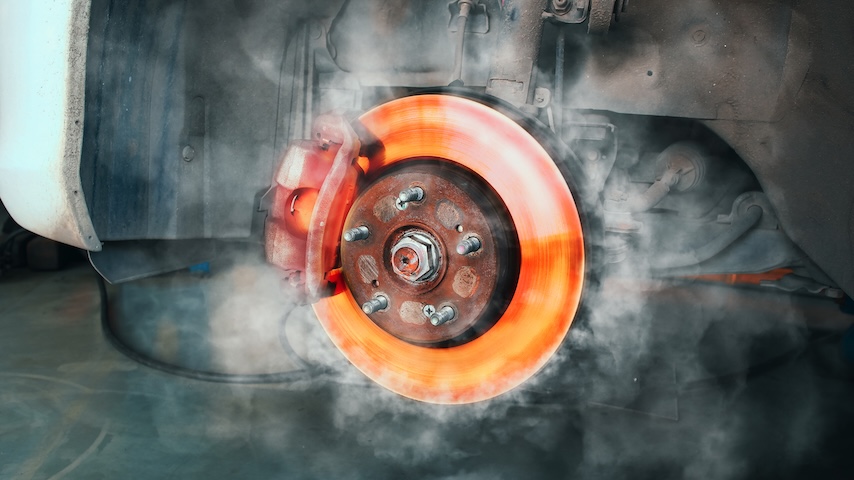Emissions From Braking Can Adversely Affect Human Lung Cells
Emissions From Braking Can Adversely Affect Human Lung Cells


Particles emitted from non-asbestos organic pads were found to be more toxic to human lung cells than diesel exhaust particles.
Researchers at University of Southampton find brake pads containing copper release particulate matter that may harm lung health.
Most of us equate all pollution from vehicles with tailpipe emissions. Such a view ignores other aspects of driving, such as braking, which also contributes to particulate matter in the environment, said Professor Matthew Loxham from the University of Southampton, England. It’s why a move to electric vehicles will decrease a significant percentage of all emissions but not eliminate them. We will still have to contend with particulate matter emissions from braking, as well as tire and road wear.
Loxham and lead researcher James Parkin found that when braking, vehicles with brake pads containing copper emit particulate matter that can harm human lung cells.
Particulate matter in the environment is usually measured and regulated as a certain mass per cubic meter. Still, such a monolithic number doesn’t account for the diverse range of sources that constitute it, Loxham said. When evaluating their effect on human health, both the composition and the size of the particulate matter are considered.
To study the effect of emissions from brake pads on lung function, Parkin and Loxham evaluated four standard brake pads available on the market: low-metallic, semi-metallic, non-asbestos organic, and ceramic pads. Different brake pads serve different functions because they have different blends of properties. Expensive ceramic pads, for example, find use in high-performance sports cars because they have reduced loss of braking activity at higher temperatures, Parkin said.
Relevant Reads: Graphene Additive to Cut Concrete Emissions
The research team received emissions data from collaborators at the National Institute for Public Health and the Environment (RIVM) in the Netherlands, who tested brake pads under conditions designed to mimic real-world driving scenarios. Mass spectrometry evaluated the elemental composition. To study the toxicological effects of the emissions, the team grew cultures of cells from a model extracted from the lining of the lungs. They then exposed the cells to varying amounts of particulates for different lengths of time. The team was particularly interested in particulate matter, specifically PM2.5, which is about 30 times smaller than the diameter of a human hair and more easily reaches the deepest regions of the lungs.
The research found that copper in the released particles contributes to their effects. Particles emitted from non-asbestos organic pads were found to be more toxic to human lung cells than diesel exhaust particles. A 2019 report indicated that road, brake, and tire wear together contributed to 7.4 percent of all primary PM 2.5 emissions in the UK.
“The irony is that copper was introduced as a replacement for asbestos to comply with legislation that wanted to eliminate the risk of asbestos in the air,” Loxham said.
California and Washington have passed legislation to mandate low copper content in brakes for another reason: to limit copper from entering waterways. The California law mandated reduction of copper content in brakes to 5 percent and to almost zero in 2025.
Sudden braking can create high temperatures simply by the amount of friction generated.
“Braking from a high speed increases the temperature at the brake rotor, the interface between the brake pad and the disc,” Parkin said.
You May Want To Read: Leading Hard-to-Decarbonize Industries to Zero Emissions
At a “critical temperature”, melting of the binders within the pad emits large volumes of ultrafine particles. Because it possesses excellent thermal conductivity, copper helps spread the heat generated by braking, reducing hot spots of high temperatures in the brake pads. This improves braking performance and reduces the wear rate of the brakes, allowing them to last longer.
All vehicles have to brake, but the amount of dust generated as a result depends on their speed and weight. Bicycles, for example, emit significantly less pollution than cars. There can also be a buildup of brake wear particles from subway trains, where poor ventilation can diminish their dispersal.
“The research paves the way for related policies although “our job as scientists is to present the science in a way that policymakers can easily digest and work out what the solutions might be,” Loxham said.
Nevertheless, solutions to address the problem from brake pad emissions include tackling braking functions. Traffic calming, for example, includes creating a series of low humps on roads to slow traffic intentionally. But cars rapidly braking to navigate them could increase emissions. The key is to maintain a steady driving speed, rather than constantly accelerating and braking. Self-driving cars could also consider these factors when designing algorithms for speed and safety. Washing road surfaces and changing the composition of the brake materials and road surfaces are additional alternatives worth exploring.
Discover the Benefits of ASME Membership
“There have been experiments to add humectants to roads so the surface is moist,” Loxham said.
“Many electric vehicles use regenerative braking to drop from high to low speeds, which will reduce brake wear emissions by much more than half,” Loxham said.
However, because electric vehicles are heavier, they generate more tire and road wear, which is a factor to consider when crafting future public policy. The bottom line is that the problem is complex with no straightforward solutions.
Loxham emphasizes that the research is not intended to suggest that the switch to electric vehicles is inherently bad. After all, they have zero emissions from the tailpipe, with diesel exhaust particles being a recognised carcinogen and other exhaust gases being harmful as well.
“What we’re saying here is that there are sources of emissions that may not be rid of completely when you stop burning diesel,” he said.
Poornima Apte is a technology writer in Walpole, Mass.
Most of us equate all pollution from vehicles with tailpipe emissions. Such a view ignores other aspects of driving, such as braking, which also contributes to particulate matter in the environment, said Professor Matthew Loxham from the University of Southampton, England. It’s why a move to electric vehicles will decrease a significant percentage of all emissions but not eliminate them. We will still have to contend with particulate matter emissions from braking, as well as tire and road wear.
Loxham and lead researcher James Parkin found that when braking, vehicles with brake pads containing copper emit particulate matter that can harm human lung cells.
Researching brake pad emissions
Particulate matter in the environment is usually measured and regulated as a certain mass per cubic meter. Still, such a monolithic number doesn’t account for the diverse range of sources that constitute it, Loxham said. When evaluating their effect on human health, both the composition and the size of the particulate matter are considered.
To study the effect of emissions from brake pads on lung function, Parkin and Loxham evaluated four standard brake pads available on the market: low-metallic, semi-metallic, non-asbestos organic, and ceramic pads. Different brake pads serve different functions because they have different blends of properties. Expensive ceramic pads, for example, find use in high-performance sports cars because they have reduced loss of braking activity at higher temperatures, Parkin said.
Relevant Reads: Graphene Additive to Cut Concrete Emissions
The research team received emissions data from collaborators at the National Institute for Public Health and the Environment (RIVM) in the Netherlands, who tested brake pads under conditions designed to mimic real-world driving scenarios. Mass spectrometry evaluated the elemental composition. To study the toxicological effects of the emissions, the team grew cultures of cells from a model extracted from the lining of the lungs. They then exposed the cells to varying amounts of particulates for different lengths of time. The team was particularly interested in particulate matter, specifically PM2.5, which is about 30 times smaller than the diameter of a human hair and more easily reaches the deepest regions of the lungs.
The research found that copper in the released particles contributes to their effects. Particles emitted from non-asbestos organic pads were found to be more toxic to human lung cells than diesel exhaust particles. A 2019 report indicated that road, brake, and tire wear together contributed to 7.4 percent of all primary PM 2.5 emissions in the UK.
The role of copper
“The irony is that copper was introduced as a replacement for asbestos to comply with legislation that wanted to eliminate the risk of asbestos in the air,” Loxham said.
California and Washington have passed legislation to mandate low copper content in brakes for another reason: to limit copper from entering waterways. The California law mandated reduction of copper content in brakes to 5 percent and to almost zero in 2025.
Sudden braking can create high temperatures simply by the amount of friction generated.
“Braking from a high speed increases the temperature at the brake rotor, the interface between the brake pad and the disc,” Parkin said.
You May Want To Read: Leading Hard-to-Decarbonize Industries to Zero Emissions
At a “critical temperature”, melting of the binders within the pad emits large volumes of ultrafine particles. Because it possesses excellent thermal conductivity, copper helps spread the heat generated by braking, reducing hot spots of high temperatures in the brake pads. This improves braking performance and reduces the wear rate of the brakes, allowing them to last longer.
All vehicles have to brake, but the amount of dust generated as a result depends on their speed and weight. Bicycles, for example, emit significantly less pollution than cars. There can also be a buildup of brake wear particles from subway trains, where poor ventilation can diminish their dispersal.
Possible solutions
“The research paves the way for related policies although “our job as scientists is to present the science in a way that policymakers can easily digest and work out what the solutions might be,” Loxham said.
Nevertheless, solutions to address the problem from brake pad emissions include tackling braking functions. Traffic calming, for example, includes creating a series of low humps on roads to slow traffic intentionally. But cars rapidly braking to navigate them could increase emissions. The key is to maintain a steady driving speed, rather than constantly accelerating and braking. Self-driving cars could also consider these factors when designing algorithms for speed and safety. Washing road surfaces and changing the composition of the brake materials and road surfaces are additional alternatives worth exploring.
Discover the Benefits of ASME Membership
“There have been experiments to add humectants to roads so the surface is moist,” Loxham said.
“Many electric vehicles use regenerative braking to drop from high to low speeds, which will reduce brake wear emissions by much more than half,” Loxham said.
However, because electric vehicles are heavier, they generate more tire and road wear, which is a factor to consider when crafting future public policy. The bottom line is that the problem is complex with no straightforward solutions.
Loxham emphasizes that the research is not intended to suggest that the switch to electric vehicles is inherently bad. After all, they have zero emissions from the tailpipe, with diesel exhaust particles being a recognised carcinogen and other exhaust gases being harmful as well.
“What we’re saying here is that there are sources of emissions that may not be rid of completely when you stop burning diesel,” he said.
Poornima Apte is a technology writer in Walpole, Mass.





